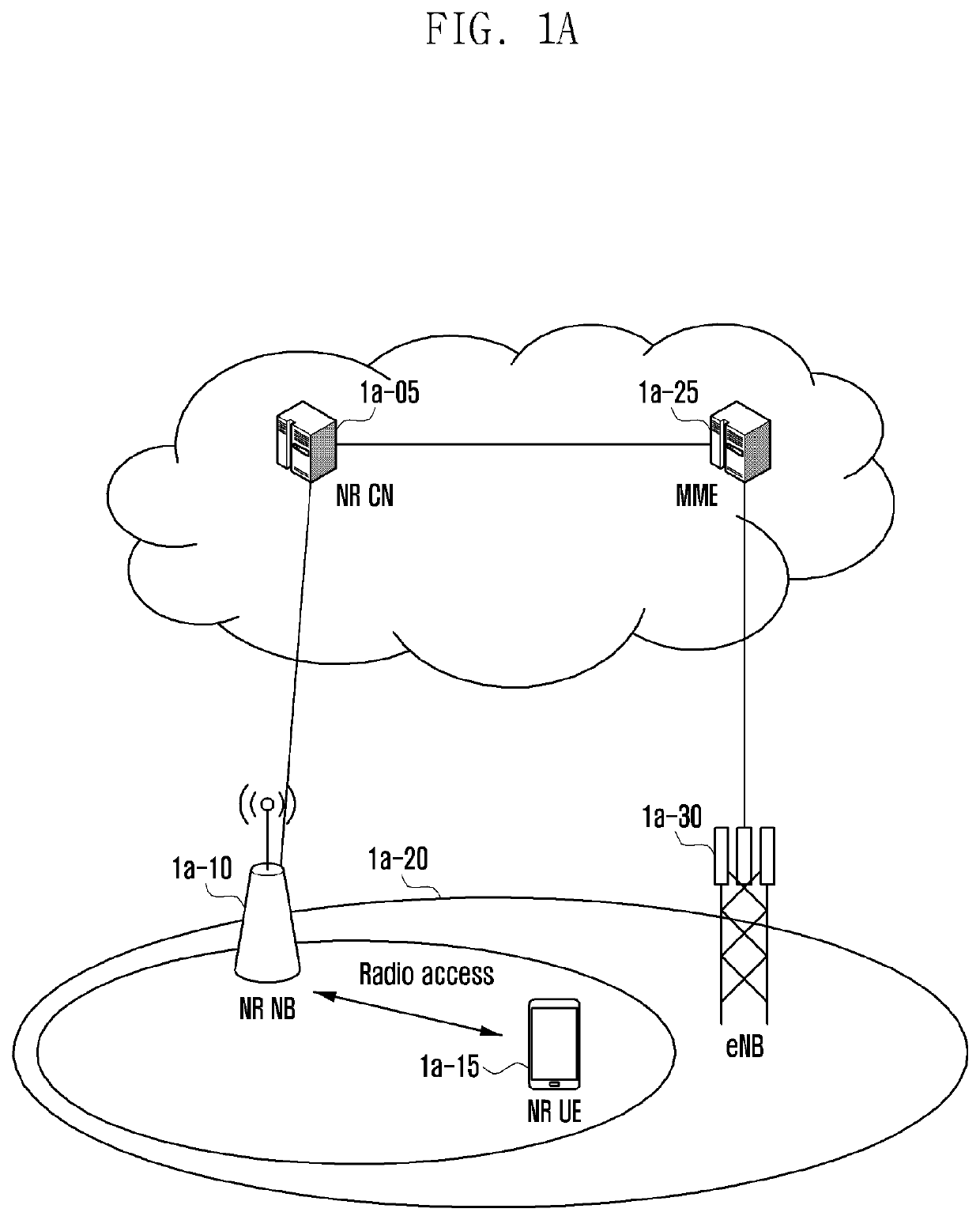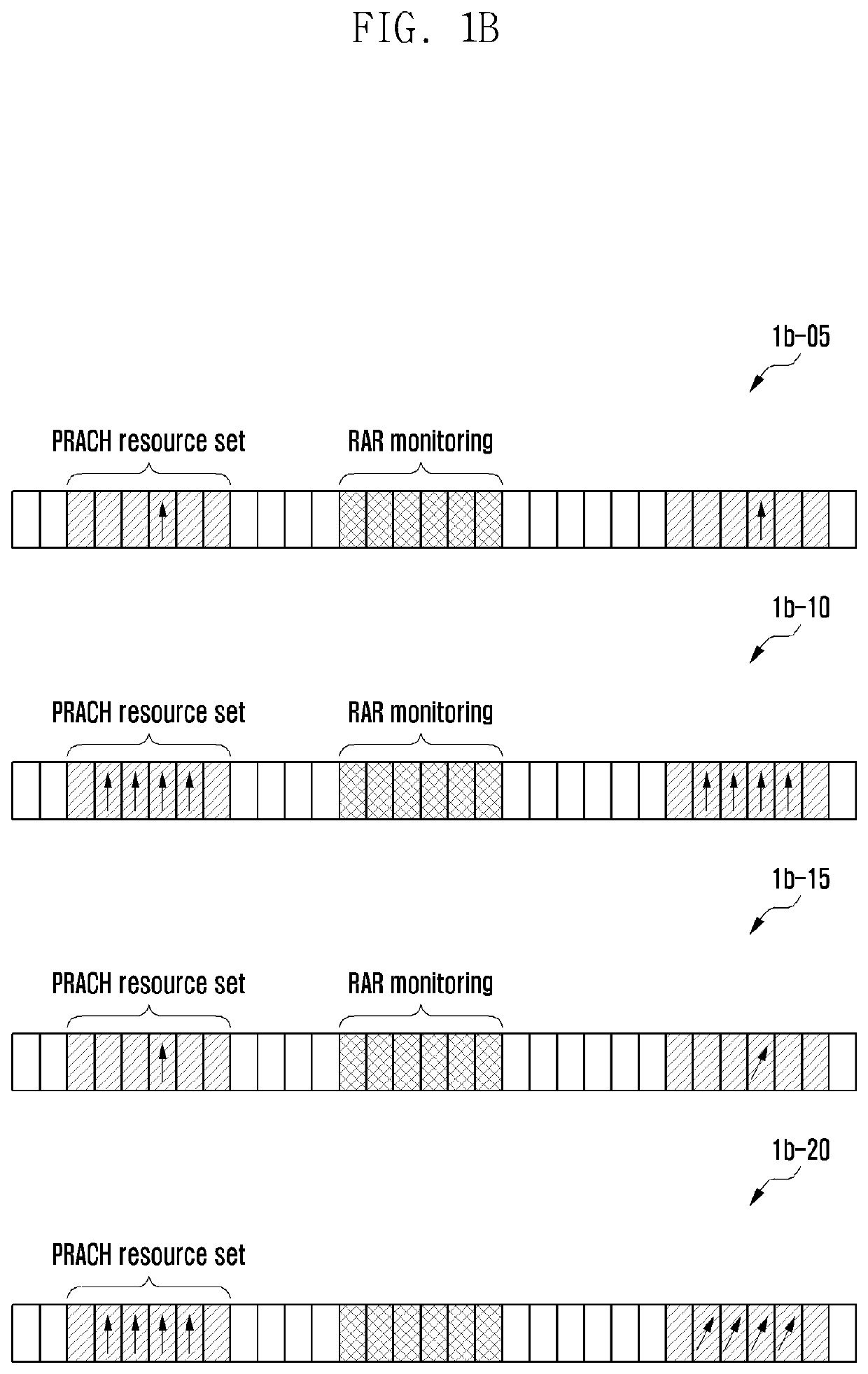Method and device for efficient communication in next generation mobile communication system
- Summary
- Abstract
- Description
- Claims
- Application Information
AI Technical Summary
Benefits of technology
Problems solved by technology
Method used
Image
Examples
embodiment 1
[0063]FIG. 1A illustrates the structure of a next-generation mobile communication system according to an embodiment of the disclosure.
[0064]Referring to FIG. 1A, a radio access network of the next-generation mobile communication system includes a next-generation base station 1a-10 (hereinafter, referred to as a new radio node B (NR NB) or a base station) and a new radio core network (NR CN) 1a-05, as illustrated in FIG. 1A. A user terminal 1a-15 (hereinafter, referred to as a new radio user equipment (NR UE) or a terminal) accesses an external network through the NR NB 1a-10 and the NR CN 1a-05.
[0065]In FIG. 1A, the NR NB 1a-10 corresponds to an evolved Node B (eNB) in a conventional UE system. The NR NB 1a-10 may be connected to the NR LTE 1a-15 and may provide better service than a conventional node B. Since all user traffic is served through a shared channel in the next-generation mobile communication system, a device for collecting and scheduling status information of buffer sta...
embodiment 2
[0155]FIG. 2A illustrates the structure of a next-generation mobile communication system according to an embodiment of the disclosure.
[0156]Referring to FIG. 2A, a radio access network of the next-generation mobile communication system includes a next-generation base station 2a-10 (hereinafter, referred to as a new radio node B (NR NB) or a base station) and a new radio core network (NR. CN) 2a-05 as illustrated in FIG. 2A. A user terminal 2a-15 (hereinafter, referred to as a new radio user equipment (NR UE) or a terminal) accesses an external network through the NR NB 2a-10 and the NR CN 2a-05.
[0157]In FIG. 2A, the NR NB 2a-10 corresponds to an evolved Node B (eNB) of the conventional LTE system. The NR NB 2a-10 may be connected to the NR LTE 2a-15 and may provide better service than a conventional node B. Since all user traffic is served through a shared channel in the next-generation mobile communication system, a device for collecting and scheduling status information of buffer ...
embodiment 3
[0252]FIG. 3A illustrates the structure of an UE system according to an embodiment of the disclosure.
[0253]Referring to FIG. 3A, a radio access network of the LTE system includes next-generation base stations 3a-05, 3a-10, 3a-15, and 3a-20 (hereinafter, referred to as evolved node Bs (ENBs), Node Bs, or base stations), a mobility management entity (MIME) 3a-25, and a serving gateway (S-GW) 3a-30 as illustrated in FIG. 3A. A User Equipment 3a-35 (hereinafter, referred to as a UE or a terminal) accesses an external network through the ENBs 3a-05, 3a-10, 3a-15, and 3a-20 and the S-GW 3a-30.
[0254]In FIG. 3A, the ENBs 3a-05, 3a-10, 3a-15, and 3a-20 correspond to the existing node Bs of the UMTS system. The ENB 3a-05 is connected to the UE 3a-35 through a radio channel, and performs a more complicated role than a conventional node B. In the LTE system, since all user traffic including a real-time service such as a VoIP (Voice over IP) through an Internet protocol is served through a share...
PUM
 Login to View More
Login to View More Abstract
Description
Claims
Application Information
 Login to View More
Login to View More - R&D
- Intellectual Property
- Life Sciences
- Materials
- Tech Scout
- Unparalleled Data Quality
- Higher Quality Content
- 60% Fewer Hallucinations
Browse by: Latest US Patents, China's latest patents, Technical Efficacy Thesaurus, Application Domain, Technology Topic, Popular Technical Reports.
© 2025 PatSnap. All rights reserved.Legal|Privacy policy|Modern Slavery Act Transparency Statement|Sitemap|About US| Contact US: help@patsnap.com



